MILITARY INTELLIGENCE
(1987-1994)
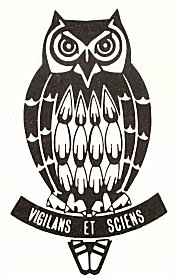
This is the Badge of South African Military Intelligence
SADF Military Intelligence Directorate
I was called up for SAMS, July 1985 intake. I did my basics at Klipdrift just outside Potchefstroom. After basics, was posted to 1 Military Hospital for the duration of my National Service. I worked as a medic in occupational therapy and helped out daily in the security wards; 25 and 15. I ended up as a L/Cpl. I had my first contacts with the intelligence community, during my National Service days. I joined MI, as a SAMID (South African Military Intelligence Division) member, after my National Service. Served under the following CSIs:
Adm Putter, Lt Genl Witkop Badenhorst and Lt Genl van der Westhuizen.
Served in DTech-Directorate Technology and briefly with DCC-Directorate Covert Collection and DOC-Directorate Overt Collection. Served mostly in an EW capacity.
Although I worked mostly in civvies, during my military career, there was only one uniform I never wore; the SA Navy one. Most of my work was done outside the borders of the RSA and SWA, mostly in French - African speaking countries. Because of all the political changes of 1994, I resigned from the Force. However, after Mandela & Co took over, I was asked to return to service. After serving with MI, the rest of my life will be an anticlimax. In my heart, I'm still and will always be a proud ex SAMS Medic.
Manuel Ferreira
THE GREAT PIRATE
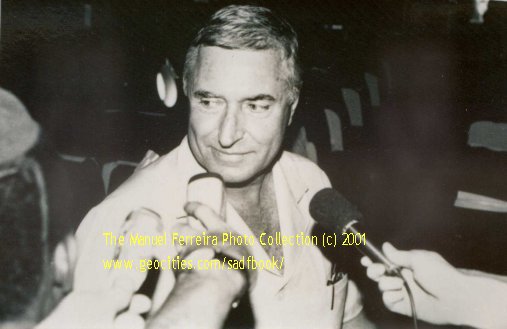
Bob Denard speaking to the press, Moroni December 1989. Just before he was forced to leave the island with his white mercenaries and hand his forces, Garde Presidentielle over to the invading French Forces.
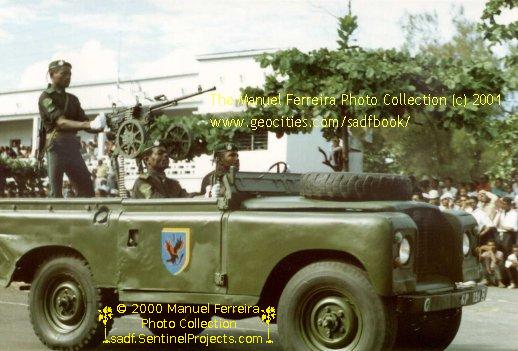
GP Parade 1: Garde Presidentielle (Bob's army) on parade Moroni.
The day I met Bob Denard.
I was sitting in my office when the telephone rang. It was a female Major from `Counter Intelligence'. She wanted to see me. Her office was just a couple of floors above mine in the Liberty Life building; the Headquarters of Military Intelligence.
In her office, she told me that she had a couple of questions for me. It was a few days before my departure to the Comoros, my first of many trips to these beautiful Islands.
`What passport do you use?' she asked me.
`Mine,' I replied.
She was shocked. `You can't use your own passport. I'll have to issue you with another one.'
But there wasn't time for a new passport to be issued. I had to use my own passport.
`What is your cover story?' the Major then asked me.
`I am a Belgian businessman,' I replied.
At least she liked this answer from me.
Then she asked me; `Who in you family knows that you are going to the Comoros? Who will take you to the airport? etc etc etc.
`Just my wife and my mother,' I told her.
Again she was shocked. `That is a breach of security!' she told me.
I had to patiently explain to her that my mother also worked here at the same place that I did, and that my wife had also been in the Defence Force for many years, and that she was in contact with the Comoros patients. She still wasn't happy and she spent the next fifteen minutes telling me what I could and couldn't do. I felt like a primary school child having to sit and listen to a boring teacher. I felt like telling her a few home truths, but I left it. They (counter int.) were actually just a pain in the arse.
31st December
I flew to the Comoroes. I was so excited. I was going to meet a man I admired. "The Great Pirate, The Greatest Dog of War of all Times", old Bob.
A couple of hours later we landed at Hahaya Airport, North of Moroni. As I disembarked, I immediately felt the terrible humidity in the air. It is something that hits you immediately. It's terrible. All around the airport I could see `Bob' Soldiers patrolling the airport.
Someone came to fetch me from the airport and take me to the camp, where I saw a couple of familiar faces. Everyone was just telling me about the great New Year party that would happen that night at Garde Presidentielle.
That night we all went to the "Centre Nautique" - the officer's mess of the Garde Presidentielle - for the New Years party.
When we arrived there (it was pitch black), I could not believe my eyes. The mess was surrounded by dozens of heavily armed black soldiers. `What is going on?' I asked. `Is Bob worried about an attempt on his life?'
There was already a party mood inside the mess. As I went in I caught my first glimpse of the French mercenary. `Where is Bob?' I asked. Someone pointed him out to me. There he was! Actually he was just an old man, sitting next to his Comorian wife.
We had a very pleasant time that night with the best of French Cuisine, seafood, Don Perignon Champaign etc. As the clock ticked towards midnight, the party became ever more rowdy. Some of Bob's men began to get out of hand. Bob spent the whole evening sitting quietly next to his beautiful wife, at the head of the table. Later I got to know him better, and we had several more enjoyable functions in his company. He was actually a quite man, at least in his advanced years.
A couple of years later Bob Denard saw another chance to show the world his true colours.
"OLD SOLDIERS NEVER DIE"
PIET RAT
"Piet" is not on the photos:
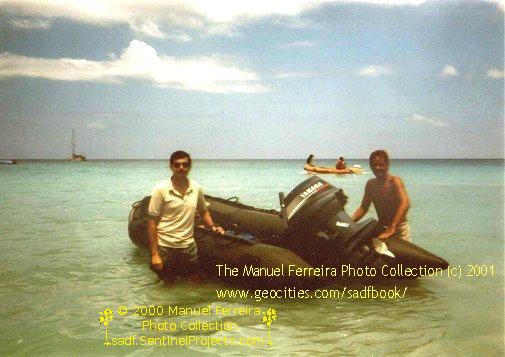
Comores 1
Life pleasures in the Comores. Our brand new rubber duck. It was used by a group of Recces that gave training to the GP. On the departure of the Recces from the island, I had the courage to ask Genl AJM Joubert, at that stage deputy CSI, that the rubber duck stayed behind. He gave his consent after a lekker braai, so thanks to the General we inherited the boat from the Recces. In the photo: In the left author, to my right CPO David Lopes (SAN EW).
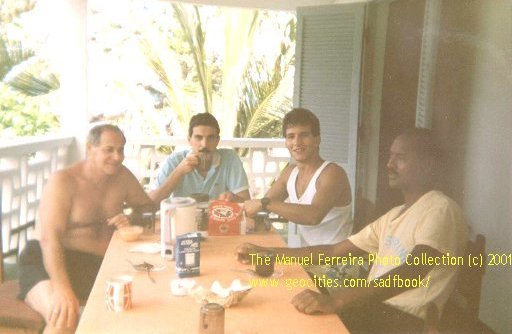
Comores 2
Tea time at our EW Station. Left to right: Alberto Castro, MI member ex PIDE (Portuguese Secret Police), author in blue shirt, Portuguese NSM from 2 SIG and SAN CPO (EW).
PIET RAT
This incident happened in the Comores Islands in 1989. `Piet' is not his real name.
Saturdays were the highpoint of the week during my three-month deployment in the Comoros. We would go and wait for the SAA flight from Jan Smuts which brought the Diplomatic postbag full of newspapers, letters from home and sometimes a video or two of rugby matches. (Up the Blue Bulls!)
This particular Saturday in 1989 was no exception to the rule. We collected the mailbag and returned to the base that was on the main road between the airport and Moroni. All that could be seen of the base from the main road was the guardroom and there were always two guards of the "GARDE PRESIDENTIELLE" (Bob Denard's army) on duty.
It was already dark, and everyone was in their own corner busy reading letters from home, or paging through the newspapers when suddenly we heard one of the guards shouting at us, and at the same time start running towards us.
He screamed at us in French; `Lieutenant, there is a white man at the gate.' (We SADF non-commissioned officers were made up to Lieutenants during our deployment in the Comores.)
A colleague and I climbed into our bakkie (pick-up) and drove to the gate. There we found a man, very confused, with his luggage at his side.
He started speaking to us in Afrikaans, and he told us that he was an AO II in the SADF and he had been sent there to give the "GARDE PRESIDENTIELLE" a week-long course in artillery and that we had been supposed to meet him at the airport. He told us that when we had not arrived in two hours, he hired a taxi and told the taxi driver to take him to Col Bako (Bob Denard‘s code name). When he arrives, the guards hone their spotlights on him and turned out with their weapons.
I told him to calm down, and we took him back to our house.
I went to the `M L' room and radioed the Military Attache and reported the incident, and that Piet came over as genuine. After a couple of days, Pretoria apologised for not having warned us in time of Piet's arrival.
That evening Piet got the available `VIP' room, and we wished him a good night's sleep. The next morning everyone asked Piet whether he had slept well, and he answered directly; `Fuck no! The room was full of rats. They spent the whole night looking at me, and me looking at them.'
From that moment on he was known as `Piet Rat'.
After Sunday lunch, Piet asked us if we could get our hands on any `blue movies' for him, as he had never seen one before. No problem! We took him to a video shop where he took out about ten French black and white blue movies. Excited at his `find', he immediately commandeered the TV and video machine, and treated it as his own from then on!
On Monday morning, everyone was waiting for Piet Rat at the main base of the GARDE PRESIDENTIELLE army barracks to start the training course.
At the mealtime, us South Africans were very surprised to see Piet Rat sitting next to Bob Denard at the head table in the officer's mess. That honour was officially reserved for proper VIP's like SADF generals.
In the best French tradition, everything came to a stand still from the mealtime to 15H00, during which when we had a siesta.
Piet Rat used this siesta time to watch his videos, and after supper he would go back again for more `action'. He must have watched those videos over and over a thousand times. He couldn't get enough of them. Everyone in the house was sick of them, except for Piet.
The week passed quickly, and on Saturday we took Piet Rat to the airport for his return flight. He had finished his assignment.
His parting words were; `Now my wife is going to crap herself!' I had thought the same thing myself. His poor wife! Piet was returning as a `Sex Expert'.
THE KILLING OF A PRESIDENT
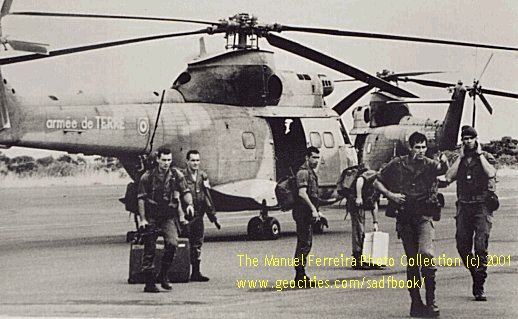
French invades: French, helio transported special troops invade the Comores, point of landing, Hahaya airport north of Moroni.
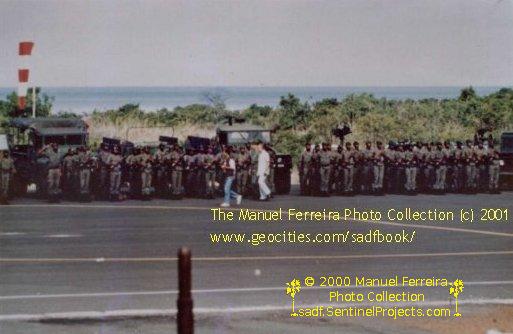
Departureday 1: Bob Denard, reviews his loyal troops for the last time at the airport. After the review, Denard hands his forces over to the invading French commander, boards a Safair C130 and goes to live in exile in the RSA. Denard is dressed in a white safari suit.
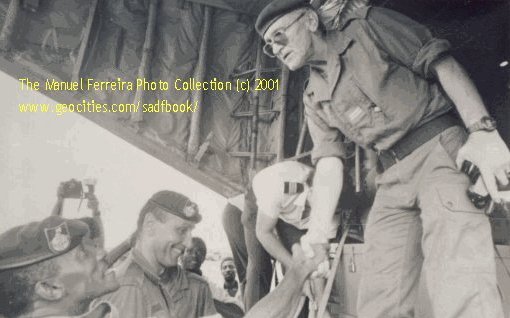
Departureday 2: White GP mercenaries board the Safair C130 in uniform and armed. In photo a white GP officer says his goodbyes to his fellow black colleague.
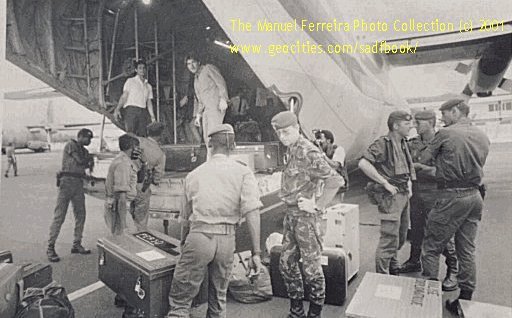
Departureday 3: GP white mercenaries load their possessions aboard South African Safair C130.
NOTE In the background French Air Force C160 can be seen.
THE KILLING OF A PRESIDENT
Gilbert Bourgeaud, codename Colonel Bob Denard, had it all in life. The professional private soldier had his own islands, his own army and got married to many attractive woman.
He is living proof that bravery, secrecy and loyalty are keys to survival in battle "and some will say in a court of law as well".
On the military side all looked normal. The SADF paid for the GARDE RESIDENTIELLE budget, $ 6 million annually, having taken over from the Rhodesians. All military projects and cooperation with the SADF were running smoothly.
We just had a group of Recces under the command of a Cmdt (Lt Col) giving the GP, Special Forces military instruction. At the end of the course several SADF generals and other senior rank visited the Comores to attend the graduation ceremony.
In the political front all was starting to go wrong and against Denard and his empire.
Denard was in charge of the GARDE PRESIDENTIELLE a formidable military force of 500 local soldiers and 30 white mercenaries. This force was created by himself, first with the assistance of Rhodesia and later of the South Africans.
To take the spotlights away from him, he had some time before announced his retirement and appointed his right hand man Dominique Malacrino alias Commandant Marques, his 2IC, Chief of the GP. In reality he was still in full charge, military and politically of the Republique Federale Islamique des Comores.
The President Abderahmanne Ahmed Abdullah was just a puppet in his hands.
To make his case a more legitimate one, he became a follower of the prophet Mohammed and Islam, took up the name of Said Mustapa Madhjoub and took as a wife an attractive local woman.
In the political front, France was putting a lot of pressure on the South African government to force Denard and his mercenaries out of the Comores.
The South African diplomatic representative in the Comores, a man by the name of Roger, called a press conference on orders of Pik Botha, where he denounced Denard and demanded his immediate departure and that of his white mercenaries.
The South African Defence Force did not approve of the press conference and as a result of it, there was a lot of friction between us military and foreign affairs.
Denard retaliated immediately and expelled the SA representative from the country. A new one was appointed by Pretoria. To make matters worse a South African citizen, working for Southern Sun Hotels, was arrested by GP soldiers at the airport for taking photos and was deported to the RSA on Denard's orders.
One morning we received at our EW station a flash signal from Pretoria, informing us that the Lear Jet, was about to land in the Comores. On board the top structure of the SADF.
Our generals spent a couple of days in constant meetings with Denard. One of the generals was the Chief Staff Intelligence, Lt Genl WitKop Badenhorst.
Apparently the generals put a lot of pressure on Denard for his departure, but he refused to go along with their request/demands.
Sometime after the generals' return to the RSA, we received an Ultra Secret signal from Pretoria that our military attache had to hand deliver to Denard. Part of the bad news for Denard, was that his budget was being cut by 50% for the following year.
Facing now pressure from all quarters, including internal, life became difficult. Denard was now fighting for his survival.
"Frederick", was French and a Captain in the GP. He was in charge of the President's security and of all his personal bodyguards. "Frederick's" house was right next to the Presidential Palace in Moroni.
"Frederick" was a very pleasant chap and mixed a lot with us South Africans. Most of his spare time was spent with us either playing chess or attending our braais.
As usual "Frederick", spent several hours this particular Saturday night playing chess with us. When he was leaving, I asked him:
"Frederick" will you came around tomorrow?
No, not tomorrow, we have night exercises. This was his answer to me.
I must confess that nothing seemed strange with his answer that night. After all the Recces had left recently and night exercises, by the GP the following night, sounded genuine.
Sunday night, just before I went to bed, all hell broke loose; a lot of shooting and tracers could be heard and seen from Moroni.
I said to my comrades: `It must be "Frederick" and his night exercises.'
Next morning as usual, I was the first up in the "ML" room, as I entered it, I heard our military attache calling me frantically over the radio: ` Manuel, nobody is to leave the station, the President was killed last night!!'
Bob Denard accused the puppet Comorian National Army, "Forces Armees Comoriennes" and its Chief, Commandant Ahmed Mohammed, of killing the President. He dissolved the National Army and arrested its officers.
Nobody believed his story and France gave him an ultimatum to leave.
Denard refused and promised to fight back, a possible invasion by French troops to the last man.
From that time, French War ships were sighted daily on the horizon and French recce flights took place over the Grande Comore daily, at a very high altitude.
GP troops were deployed around strategic points and artillery guns were placed in Moroni facing the sea. The GPs believed that the French would invade from the sea, around the capital.
Discussions kept taking place, but Denard refused to give in.
In the meantime, we SADF personnel deployed in the Comores, were ordered by Pretoria, to break off all contacts with the GP, not to enter their barracks or eat at their officers' mess as was the norm for many years.
Our military medical doctor officer based at the GP barracks was also ordered by Pretoria to leave the barracks.
After Pretoria's orders, I was asked by our Mil attache, to go to the GP barracks and pick up about 30 crates of beer, that were paid for (nobody else had the courage to show up!). While I was loading the crates, Daniel, (an old French mercenary who was in the Comores with Denard from day one) came up to me. He did not utter a word and he gave me a dirty look.
His eyes said it all: "You South African bastards! Now that we need you more than ever, you desert us".
For the first time ever in my life, I, a BIG South African patriot, felt embarrassed for a moment about my nationality.
THE SAME OLD SHIT STORY - ON ORDERS OF FOREIGN POWERS, WE DROP OUR FRIENDS!!!!
It was the case with the whites in Angola and Mozambique who asked South Africa for help to declare a UDI in 1975. It was the case with the Rhodesians. They were dropped in the deep end on orders of the Americans, etc, etc.
It was now Denard's turn an old and good ally.
Although we were forced to stop all contacts with the GPs, Denard kept his military guards at our station to the last day, and rations were still delivered daily from the GP mess).
The rest is history, the French forces invaded, not in Moroni as the GP was expecting, but at the airport, using helio transported paras. Advanced towards Moroni and the GP's barracks, just outside the capital. After discussions and to avoid a possible bloodbath, the French agreed that Denard did not need to surrender and could leave with his white officers in a dignified way.
Denard handed his forces over to the French commander at the airport, after for a last time passing review of his loyal troops. They were allowed to board a Safair C130 armed and in uniform. Once airborne, they took off their uniform fatigues and handed their weapons over to the South African crew.
Some years later Denard was still man enough, to show the world his true calibre.
Once more he invaded the Comores, took over in a couple of days and freed some of his ex GP soldiers that had been jailed by the new order. He was loyal to his troops and they adored him.
Once more the French put a stop to his adventure, invaded the island arrested him and the French state put him up for trial for the president's murder.
In the year 1999, while on trial for the murder of the President, in a French court, Denard changed somewhat the story of what happened in that night of 27 November 1989.
He claimed that, a faked coup was undertaken by the GP that night, that would be blamed on the regular army and then forcibly disarm it. He further claimed that the President agreed to the faked coup and at 0010 hours of the 27 November signed the order to disarm the regular army, seconds later he would lay dead in his pajamas. The simulated coup had gone terribly wrong Denard claimed.
The court did not believe his version, but he and Marques were acquitted on 17 May 1999. The prosecution had failed to prove its case. Reason being that a key witness was at large since December 1998, my good old friend "Frederick".
Bob, I do not give a shit, if you killed the President or not, only you Marques and "Frederick" know exactly what happened that night, after all the 3 of you were in his room when he was shot.
I SALUTE YOU OLD BOB.
Manuel.
Ps Bob Denard with his GP, created the longest period of peace for the islands, during which time they established democratic institutions, developed the country's economic infrastructure, created companies, jobs, promoted rural development, built roads and improved humanitarian conditions.
OUR "BROTHERS IN ARMS" FROM CHILE
Chilean Air Force personnel who served in the SADF
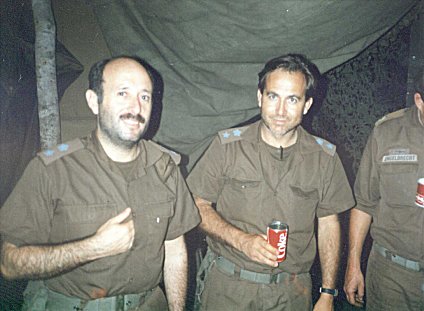
Two Chilean Air Force senior officers seconded to the SADF. Photo taken, December 1987, at 20 BDE Tactical HQ, south of Cuito Cuanavale in Angola.
Chilean Air Force fighter pilots and NCOs served in the SADF as EW (electronic warfare) Operators. They were deployed by us for a couple of months at a time. They were mainly stationed at Grootfontein, but moved around the operational area as needed. After they had served their time, they were replaced by other personnel. They worked for my unit; the Intelligence Division, Directorate of Technology.
They served in the operational area, sometimes in close cooperation with the SAAF.
The Chilean officers kept their rank in the SADF and the NCOs were made Candidate Officers so that they could live in the same mess as their officers.
Their main task was to monitor the radio frequencies and activities of the Cuban Air Force in Angola. (They became very GOOD at it!!)
A civilian woman from my unit, who was a fluent Spanish speaker was on permanent detachment with them, as the co-ordinator, and to translate their reports.
Sometimes things went wrong, and their long reports landed on my desk for me to translate. The more I protested, the more I demonstrated how poor my Spanish was, the more reports landed on my desk. I had no choice.
Their monthly reports dealt with the Cuban Air Force activity in Angola, frequencies, bases, equipment, aircraft, call signs, operations, etc etc.
Once a month a courier from the Intelligence Division (sometimes it was my mother) took money from the `blue bag' to them.
When our forces were withdrawn from South West Africa, our Chilean friends moved south to 513 TP in Rooikop, Walvis Bay. They stayed in Walvis for several months until their services were no longer needed.
Some of their officers served with us for long periods, some even bought cars. One of their pilots married a Portuguese sergeant from my unit and took her back to Santiago in Chile. This was a great loss to us, and the Brigadier (our OC) was grief-stricken.
To my `Brothers in Arms' from Chile, I say `Thank you very much!' Sadly all your hard work was for nothing.
ONS VIR JOU SUID-AFRIKA
`Oh, South Africa Dear Land'
WE NEVER MADE IT TO SOYO
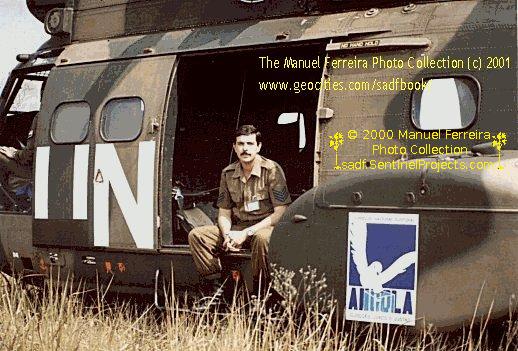
Genesis 1: Myself sitting by the door of Oryx chopper around Uige, north of Angola. Note that our choppers had I I N, painted instead of UN. We had to change the U to I I, as the UN refused to have us as part of their contingent. Did not want to be seen associated with the old South Africa.
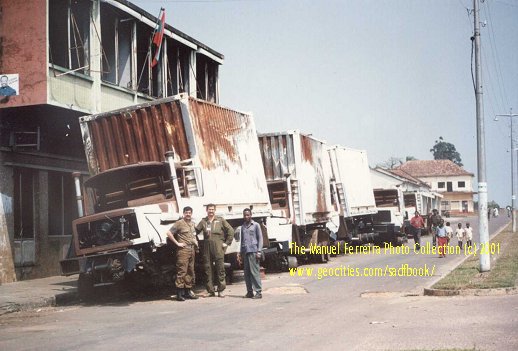
Genesis 2: Myself and Maj Jacobs, in front of UNITA HQ at Sanza Pombo, north of Angola.
Note Savimbi's poster and UNITA flag.
WE NEVER MADE IT TO SOYO
"HOW DARE THE SAAF?"
OPS Genesis Angola 1992. SAAF help with the first elections in Angola.
We were deployed in Malange at the airport with 4 ORYX Helicopters. In Luanda, at the airport there was also a small group of the SAAF, deployed with two Cessna Caravans and the commander of the operation.
We received a request from the Angolans to fly to Soyo (The North West point of Angola) to fetch a couple of officials and to fly them to a place in the North.
We left Malange at first light; Destination: Soyo.
Twenty minutes before touchdown, Soyo informed us that the airport was closed to all aircraft, and that we had to leave the area immediately. The reason: The Angolan President Jose Eduardo dos Santos was on his way to Soyo.
Now we had a problem; we did not have enough fuel to make it back to Malange. After some calculations, the Commandant (Lt Col) decided to fly to Luanda, which would leave us with precious little fuel. Thirty minutes before we reached Luanda, the Commandant called the control tower.
Luanda, This is Papa Alpha 02.
Papa Alpha 02, This is Luanda, over.
- Luanda, Papa Alpha 02, requests joining and landing instructions, flight from Soyo to yours.
Papa Alpha 02, identify type of aircraft and nationality.
- Luanda, We are a SAAF Puma, Nationality - South African.
We repeated our last request a couple of times, but Luanda did not answer us! Our fuel situation was now critical. The Commandant asked me to call the tower in Portuguese.
-Luanda, Papa Alpha Zero Dois, chama.
No reply from Luanda.
The Commandant decided to call our people at Luanda Airport on the VHF. They answered immediately, explained the situation and they ordered us to land at Luanda. We were now over Luanda, and the Commandant asked me to help him with directions because I knew the city well. A couple of minutes later we landed our ORYX at "Aeroporto Internacional de Luanda" without clearance. Our people came to meet us in a bakkie (pick-up); `Follow Me' and taxied us to the military side of the airport, we switched the engines off in front of the hanger in which the SAAF was deployed.
We were immediately surrounded by angry-looking FAPLA soldiers and UN officials.
"How dare you land in Luanda without clearance?"
"How dare you land in Luanda with a camouflaged Puma, the same Pumas that were responsible for so much killing and destruction in Angola. How dare you!!"
After much explaining and liaising, the UN managed to get us some fuel and asked us to leave the airport immediately.
While the refueling was being done, we were visited by a very pleasant FAPA (Angolan Airforce) Officer, a descendent of São Tome. He showed his admiration for us, the South Africans, and he felt honoured to be able to speak with me and to have the privilege of being able to touch a SAAF Puma, the `very famous Puma', as he referred to it. I must say that he was the exception in that area.
The helicopter was fully refuelled and engines running. We were ready to depart.
- Luanda, this is Papa Alpha 02.
No Reply.
Luanda, Papa Alpha 02, we request taxi clearance for take-off, flight to Malange.
Still no reply.
The Commandant decided to show the arrogant Luanda air traffic control officials in the tower that you don't mess around with the SAAF.
Without clearance, the Commandant lifted very aggressively and flew close by the tower.
A couple of days later the MPLA government kicked us out of Angola. We were falsely accused of many things that we had apparently done wrong.
The fact that we landed in Luanda without their permission, which in any case wasn't our fault, had also contributed to the tense situation. In any case, before the date when we were supposed to leave Angola, we returned to Luanda with our `racist camouflaged Puma' for old time's sake.
PS: Our ORYXES were called Pumas, because at that stage the project was still secret.
THE LAST FLIGHT OUT OF SAIGON
ANGOLA, 1992 OPS GENESIS
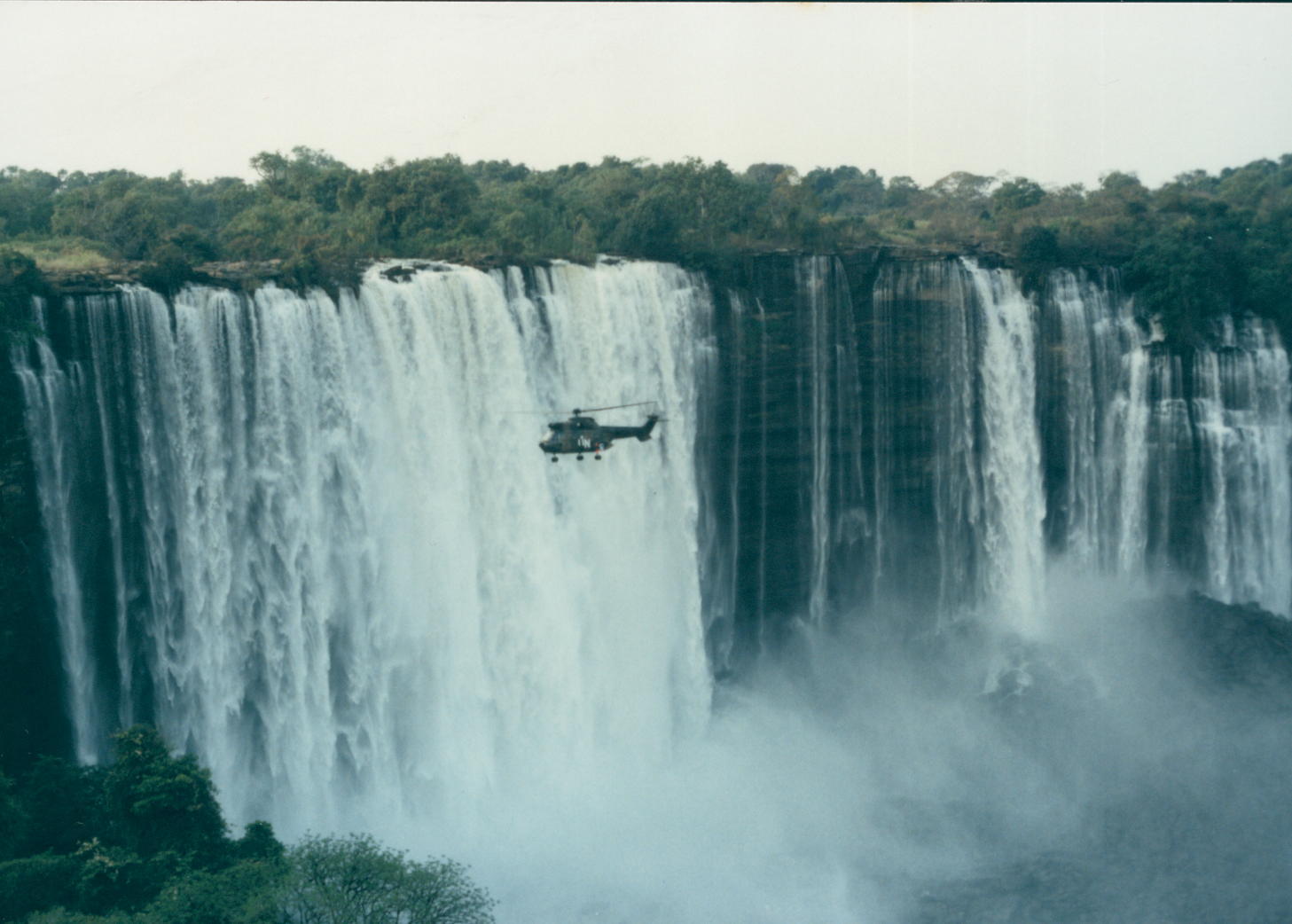
SAAF Oryx during Ops Genesis, Calandula Water Falls Angola.
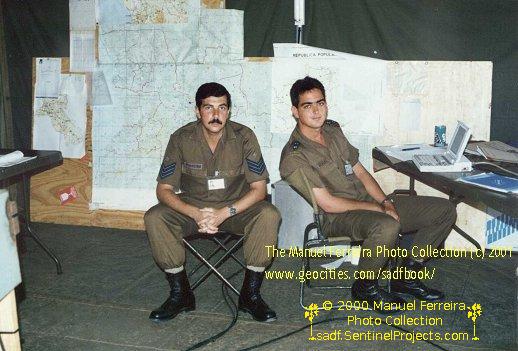
Malanje ops room: Our ops room at the Malanje airport Angola. Intelligence team:
My self and my int. officer for Ops Genesis.
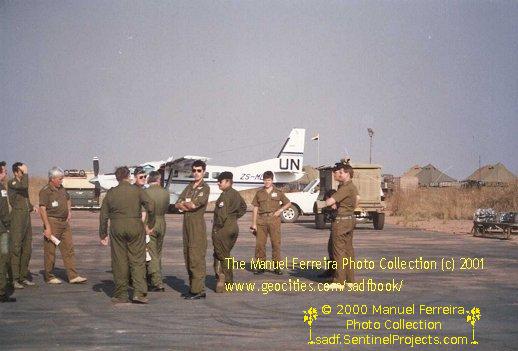
Malanje: This is a UNIQUE photo. Our camp at Malanje flying our OLD SA Flag. In the heart of MPLA country. It only flew for a couple of days. It created an international incident, between us Angola and the United Nations. We pulled the flag down on orders of Pik Botha. The Cessna Caravan is from SAAF 41 SQN, uniquely our choppers it flew with UN sign for the duration of our stay. The officer in Air Force blues in the middle of photo, is the famous SAAF Brig. Dick Lord.
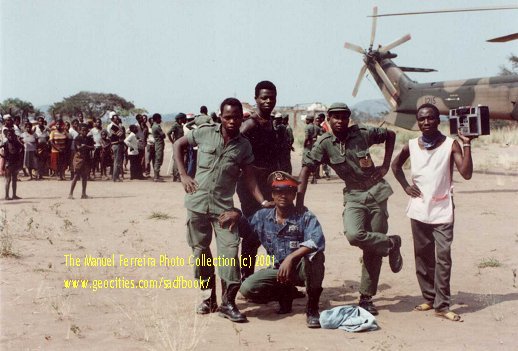
Sacandica: FAPLA soldiers pose for my camera in Sacandica, North of Angola. Border with (then) Zaire.
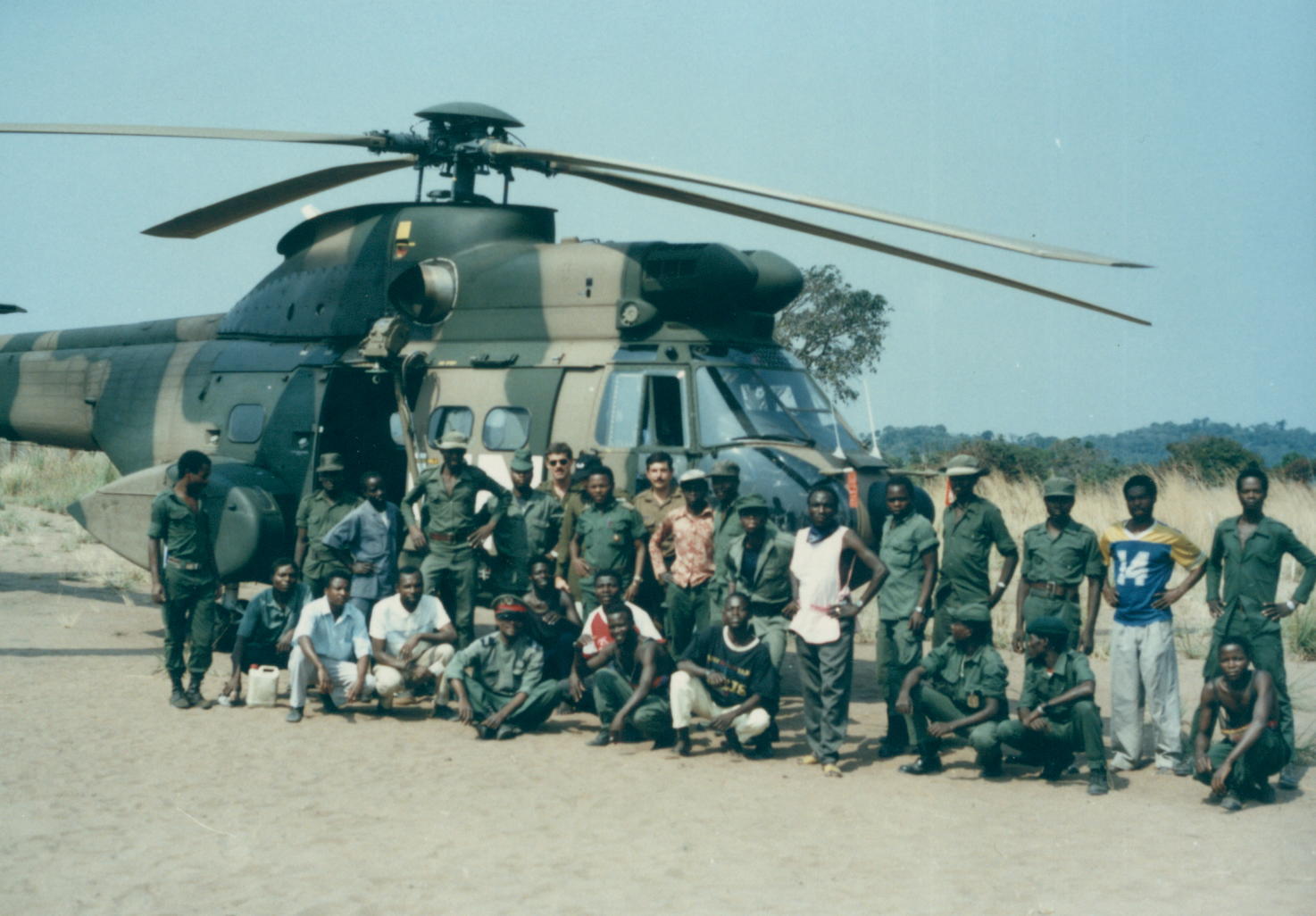
Sacandica - Angola
I managed to get UNITA and FAPLA to join me in this group photo. Both OCs next to me, to my left the FAPLA Lieutenant, and to my right in a civvy shirt the UNITA officer. Do not let this picture fool you, a few days later the two armies shot the shit out of each other. UNITA drove off those of FAPLA that were not killed. So much for peace! "CRY MY BELOVED ANGOLA"
We were busy deploying election officials in the North of Angola.
One morning when we dropped the election official off at a small village, the whole population came charging towards the helicopter. (The peace was only in paper, the war drums could be heard in the whole country. The countryside was under UNITA siege, if you came to a small village under MPLA control, everyone wanted to get out before UNITA got there! A few days after the election results were announced, the country erupted in a civil war never seen before)
I started shouting for help, as they started to swarm in to the helicopter. The pilots didn't cut the engines, and they asked the flight engineer to come and help me to get rid of the hoards. With much pushing and shoving we managed to get rid of them.Anticipating that the situation in the helicopter could get out of hand, the pilot started to ascend rapidly. Just as the helicopter lifted off, we realised that we still had two stowaways onboard. The flight engineer and I were ordered to push them out immediately, even though we were airborne. I didn't know whether the pilot was joking or not. We had managed to drag them to the door when I noticed that one of them was a woman, and she was screaming her lungs out. I told the pilot that I couldn't push them out, as they were clinging to me, and they would drag me out with them. I asked the pilot very nicely to return to the flight base. The pilot was angry for the entire journey. When we landed, the two stowaways were all Colgate-smiles and they shook our hands. They were very glad of their trip to freedom.
The pilot was still unhappy with me, and I asked him; `Koos (Not his real name), what did you expect? It was like the "LAST FLIGHT OUT OF SAIGON".' They all wanted a flight to freedom.
As a result of this incident we threatened to stop the flights, unless the Angolans improved their people's behaviour. It was endangering our helicopters and crews.
SPYFLIGHT-ANGOLA
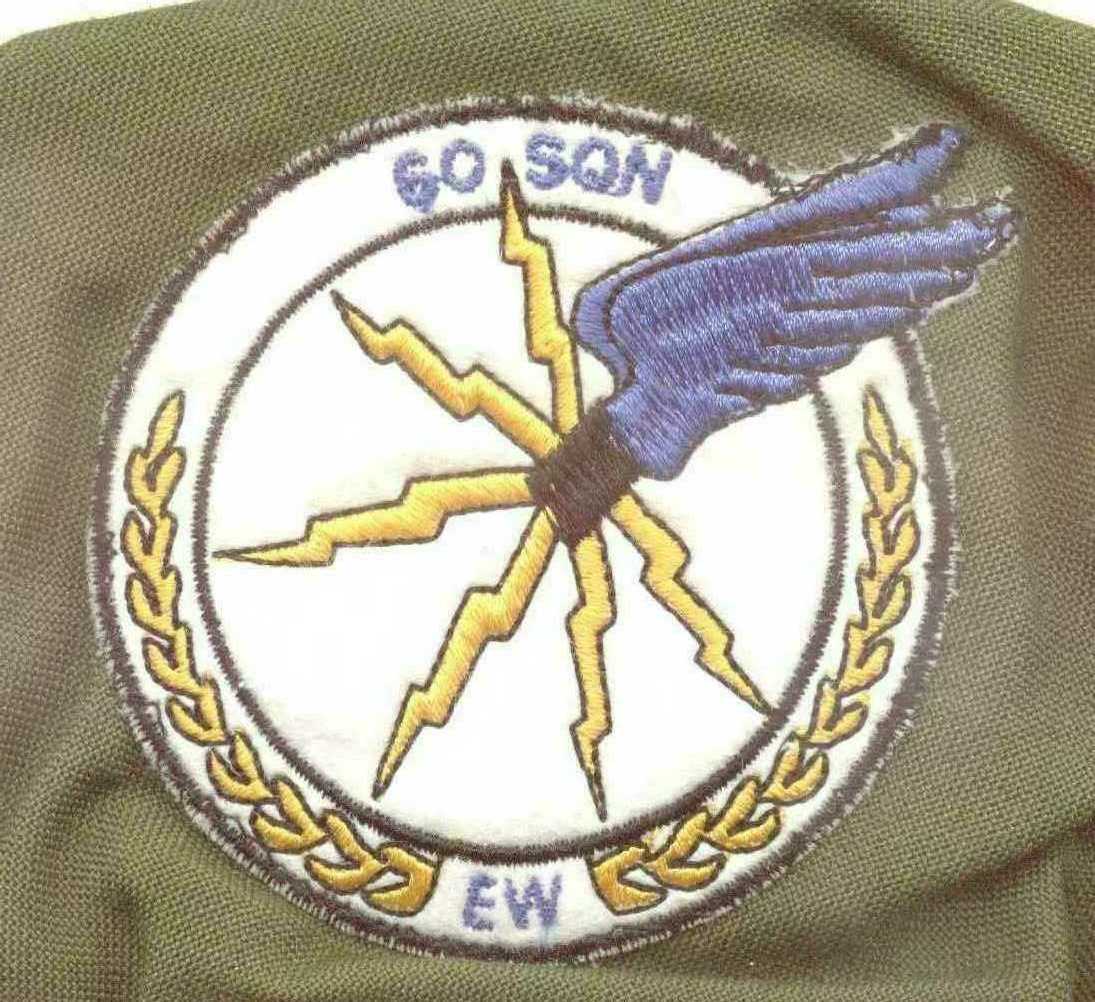
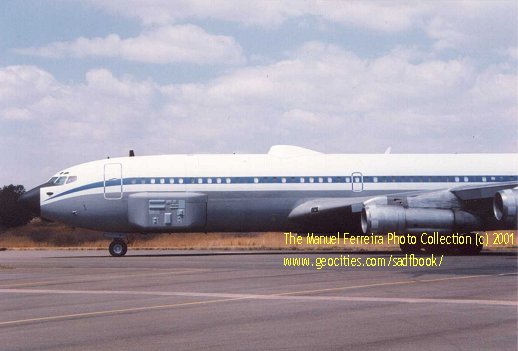
These are 2 photos of B707, Tail no 1419 of SAAF 60 Sqn. This is the plane flown on my story.
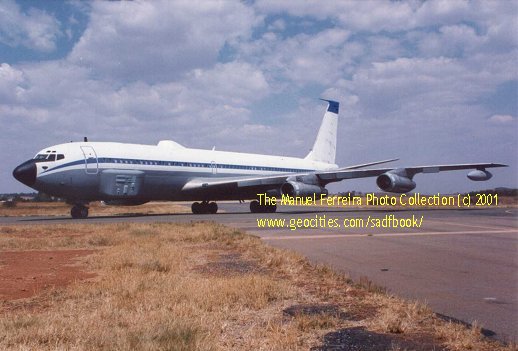
Mission: Top Secret
Place: Angola
Time. Before the country was betrayed, while the Oranje Blanje Blou (Afrikaans term of endearment for the old South African Flag) still flew/fluttered over our beloved land.
Reason: FAPA MIGS
Aircraft type: B707 60 Squadron
Waterkloof: It is 0900 in the morning and we were ready to fly to Cape Town. We had all signed the squadron logbook. After we had pulled on out flight overalls, we walked over to our aircraft. There she stood, THE PRIDE OF THE SAAF, the most secret aeroplane in the country. Her task was ELINT, (electronic intelligence) SIGINT (Signals intelligence) and AIR TO AIR REFUELLING.
Tanks full, we climbed onboard. The young Lieutenant in charge of the EW operators (Electronic warfare) was 60 Squadron's intelligence officer, and he briefed us.
`Guys, lets use this trip to DF Malan (Cape Town Airport) to test our equipment. `Manuel, you don't have to check your equipment. You can rest. There will be plenty of work for you tomorrow.'
A couple of hours later we landed at DF Malan airport and stopped at the military side of the airport. After shut down, we took a bus to Ysterplaat Airforce Base. The young intelligence officer was our driver. He knew the Mother City well, and he was a non-drinker. (How lucky we were!)
We arrived at Ysterplaat at about lunchtime. Us Warrant Officers and NCOs got the best room in the NCOs mess - the VIP room. We were all squeezed into one room. Then we went to eat.
There was a lance-corporal in the group, and one of the flight engineers, a Sergeant Major ordered him to `strip' his rank. `You aren't going to go and eat with the troops. You come an eat with us, and if anyone asks you your rank, refer him to me.'
After lunch we received a message from the OC of the mission, a Commandant, that no one was to be excused from the piss up at the Waterfront (The club and restaurant centre of Cape Town) later that night.
The intelligence officer arrived later with his bus to fetch us, and we set off for the Waterfront. There the whole crew relaxed and had a great time.
In the early hours of the morning we were driven back to Ysterplaat. No one was quite sure of the road back. The Commandant teased the two navigators, because as usual they were well off the correct route.
At 0600 next morning we set off for DF Malan. The people on the bus were exceptionally quiet. When we arrived, the two flight engineers were already there. (Did they not sleep?!)
As we climbed aboard, the adrenaline kicked in and we started to feel that excitement only experienced by aircrews.
THE MISSION IS ABOUT TO START.
We were briefed and this morning there was some concern. The aircraft had never been loaded with so much fuel before, and she was heavy. It was a very long-range mission.
Engines running, we taxied slowly to the take off point. We were already seated at our EW consoles, radios tuned in to the airport's frequency.
Engines at full power, the tower gave us clearance; " SA 01, you are cleared for take-off ". Although I am a pilot myself, I still felt nervous. The large aircraft had started to quiver as it gained speed. It used the whole length of the runway. It felt as though it took a lifetime, but eventually we were airborne.
There were two full aircrews onboard. The team not on duty for the first leg of the journey were straight to bed to rest. Some of these men put on their oxygen masks (to clean their blood).
We went straight out to see; the whole mission was to take place over the sea.
In line with Rooikop we began to pick up the Angolans. I was now in business as I was the only one of the crew who could speak Portuguese.
Later it was confirmed; `We are over, guys.'
We picked up a lot of flight traffic; some military traffic, but no Migs. In line with Luanda, more tension:
`Guys, there is a radar-lock on our aircraft.'
Migs? We doubted that, because to shoot us down, they would have to use their after-burners, and they would not have enough fuel to make it back.
Luanda Radar? We also didn't think so. Out intelligence people had let us know that the radars at Luanda were not operational.
Ship to sea? Maybe.
We reached Cabinda and it was time to turn around. The aircrew changed over, and so did the operators. The only person not replaced was me, because there was no replacement for me.
On the way back, the Angolan's activities were the same. The Migs were definitely out of action that day.
Over the border, and back over South West African water, the Lieutenant said to me; `Flight, you can go and rest now.' `Thank you, but no thank you,' I replied. `I'll stay on, because I will still be able to pick up the Angolans until the Orange River.'
As we entered South Africa, and after ten hours of electronic warfare I decided to "call it a day". Now we flew directly to Waterkloof, and as we entered the Transvaal, we found ourselves in a typical thunderstorm, our enormous aeroplane being shaken around like a paper kite. Thirty minutes before landing we switched off all the equipment and got out of our flight overalls.
After landing, we were immediately debriefed and we said goodbye to everyone. As I got out I was amazed to see how much ice had gathered on our wings.
Outside the squadron headquarters building, my wife and daughter were waiting for me.
ANOTHER MISSION COMPLETED.
I felt great!
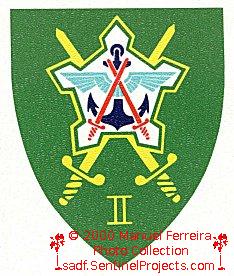
This is the shoulder flash of South African Military Intelligence
OTHER MATERIAL BY THE SAME AUTHOR
Photos: SAMS TC & 1 Military Hospital (1985-1987)
SADF Military Intelligence - (1987 - 1994)
South African Military Intelligence in Zaire (1989-1991)
SADF Military Intelligence Directorate
SADF Military Intelligence in the Comoros - (1981 to the 1990s)
Lt Domingos Jose de Almeida Vinez - 20 December 1988
Here is a shortcut back to the Sentinel Projects Home Page

